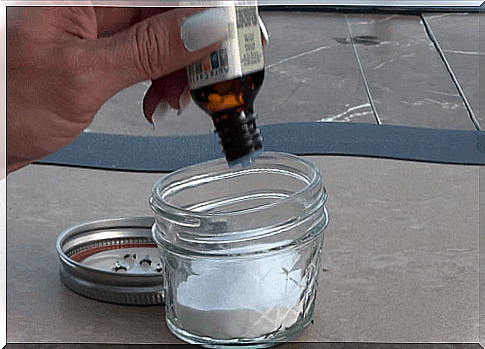Uses, Benefits And Properties Of Safflower Oil

Safflower is an oily plant, meaning it has seeds that you can extract oil from. That oil can then be used for culinary or industrial purposes. In today’s article, we are going to talk about the uses, benefits and properties of safflower oil.
Although it was originally grown for use as a dye, spice and aniline substitute, safflower began to be cultivated in the 1950s for the oil that comes from the seeds.
In fact, both the edible oils and the essential oils of this plant offer interesting benefits. For example, the edible oils are a source of unsaturated fatty acids, while the essential oils can help treat skin conditions such as acne and eczema.
With safflower oil you can make oil paint in white and other light shades. However, there are many more applications. Some of these are even linked to medication. Keep reading to learn more about this substance.
Nutritional Values of Safflower Oil
There are two different types of safflower plants. One provides more monounsaturated fats and the other more polyunsaturated fats. Each of them contains active compounds with specific nutritional properties. Let’s take a look at these differences.
Monounsaturated Safflower Oil
This oil is rich in oleic acid, a monounsaturated omega 9 fatty acid that can withstand high temperatures without losing its nutrients.
In addition, the smoke point of monounsaturated safflower oil sets it apart from other more popular products, such as corn, olive or canola oils. Therefore, it is a healthy substitute. Some people even believe that it is better to cook because the taste, color and smell of this oil is neutral.
Polyunsaturated Safflower Oil
This oil is rich in linoleic acid, an essential omega-6 fatty acid that is more sensitive than the previous one. It is therefore not good to expose this oil to high temperatures.
In addition, to prevent oxidation, keep it in a cool place such as the refrigerator. In addition, you should not expose this oil to light. Polyunsaturated safflower oil is generally sold as a dietary supplement. That’s because it contains such a high content of linoleic acid.
Also keep in mind that omega 6 fatty acids are essential for proper body function. So you have to make sure you get it through food. Our body is unable to produce it.
Also discover this article:
what are omega fatty acids 3, 6 and 9?
The uses of safflower oil for your skin

This oil has potential health benefits for your skin. That is why safflower oil is often on the ingredient lists of various types of cosmetics. If you want to use these products, all you have to do is follow the instructions on the packaging.
Plus, you can apply it directly to your skin in its pure, edible form. However, if it is an essential oil, you must dilute it with a carrier oil before using it. How do you do that? You only need to add a few drops of other oils. We recommend jojoba and grapeseed as they can help with oily skin.
This oil is considered safe. So you can use it daily. Keep in mind that the essential oils are more powerful. So you should only use it for a short period of time.
Uses of safflower oil in the kitchen
You have already read a few benefits of safflower oil. Below we will discuss the benefits of this oil that have been scientifically proven in studies.
1. It is a source of fatty acids
Safflower oil is a source of fatty acids (monounsaturated and polyunsaturated) that play a fundamental role in body function. These types of good fats are involved in hormonal regulation, memory processes and the absorption of vitamins A, D, E and K. In addition, they can make you feel full for longer.
Also, this oil contains saturated fats that are normally considered unhealthy or bad. However, it contains far less saturated fats than other popular varieties such as olive, avocado and sunflower oils.
Keep in mind that a diet high in good fats and low in bad fats is key to many health benefits, such as reduced inflammation and better heart health.
2. May Help Stabilize Blood Sugar Levels
A study published in the journal PLosS Medicine found that a diet rich in MUFA helps control your blood glucose levels.
According to the study, replacing saturated fats with unsaturated (especially polyunsaturated fatty acids) significantly improves blood sugar control, secretion and insulin resistance.
In addition, a study published in Clinical Nutrition found that consuming 8 grams of safflower oil daily for 4 months can reduce inflammation. In addition, it helped improve glucose levels in patients with type 2 diabetes.
Therefore, researchers concluded that combining a diet high in good fats with diabetes treatment is effective in reducing the complications of this disease.
3. Helps Lower Cholesterol and Promote Heart Health
The same study as above, published in Clinical Nutrition , found that taking safflower oil for 4 months could lower cholesterol levels. This shows that unsaturated fats can lower LDL or bad cholesterol.
However, that’s not the only way this compound can support heart health. The unsaturated fatty acids found in safflower oil can help prevent platelets from clumping. This in turn prevents the formation of clots. This reduces the risk of a heart attack or stroke.
4. It is a natural anti-inflammatory
Chronic inflammation can cause heart disease, autoimmune diseases and even certain cancers. Fortunately, there is now scientific evidence that safflower oil has anti-inflammatory properties. These properties reduce key markers associated with hyperactive cell responses.
5. Helps Improve Skin Health
This oil can moisturize and soothe itching and other symptoms of dry skin. That is why it is a popular ingredient in skin care products.
It has anti-inflammatory properties and also contains vitamin E. According to a study published in the Indian Dermatology Online Journal , this nutrient can:
- help treat skin conditions such as acne, psoriasis and eczema.
- improve wound healing.
Points of attention

People with bleeding disorders who are about to undergo surgery should not use this oil. That’s because it can affect clotting and increase the risk of bleeding.
For healthy adults, safflower oil is safe to use as long as you don’t exceed the recommended dose. In adults, these are the following maximum doses per day:
- Women between 19 and 30 years: 6 teaspoons
- Women over 30 years old: 5 teaspoons
- Men aged 19 to 30: 7 teaspoons
- Men over 30 years old: 6 teaspoons
When it comes to topical use on the skin, we recommend starting with a small test to determine if your skin is sensitive to it. To do this, apply a small amount to your forearm and then wait 24-48 hours. Then if you have not developed any kind of rash or irritation, you can use it.
You may also be interested in:
Post-shave skin irritation remedies
Safflower oil: an important source of unsaturated fats
Originally, people grew this plant to use it as a dye. Today, however, people are more focused on the seed. That is the part of the plant from which their coveted oil can be extracted. This is because the seeds are rich in unsaturated fatty acids that come in two forms:
- monounsaturated fatty acids that can withstand high temperatures without losing their nutrients and properties.
- polyunsaturated fatty acids which are the largest source of linoleic acid of all available products.
These unsaturated fats, along with other compounds, are responsible for controlling blood sugar, lowering LDL cholesterol and improving skin health.
When it comes to the contraindications, safflower oil is safe as long as you don’t consume more than the recommended amounts. You should also perform a skin test before using it on the skin. Also, people with bleeding problems who have to undergo surgery should avoid this product.








